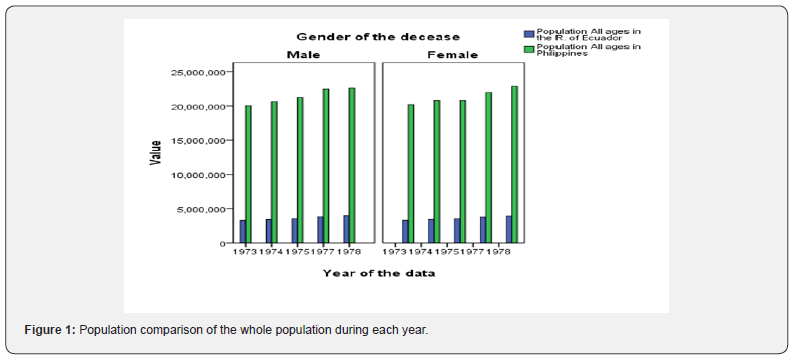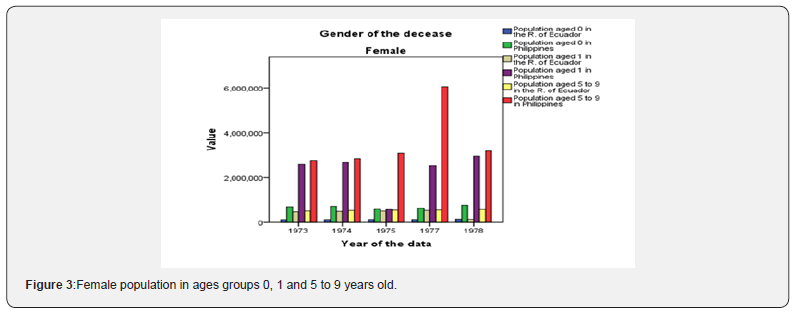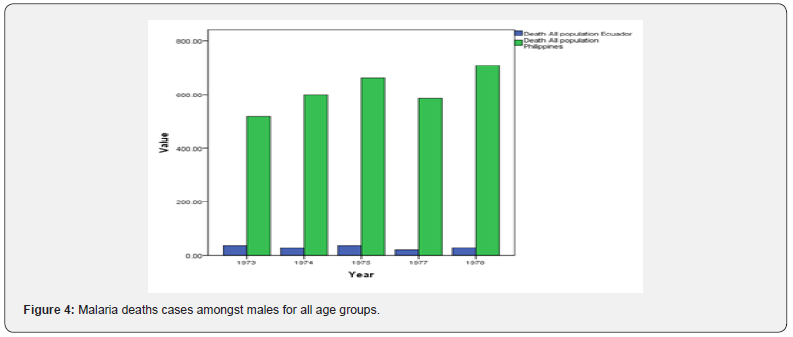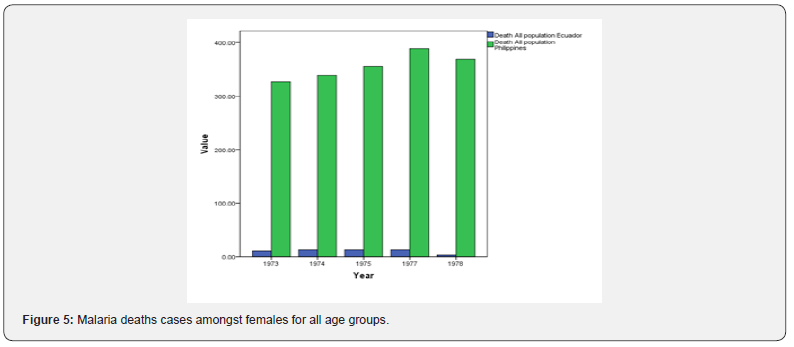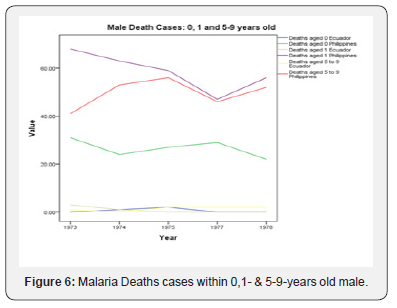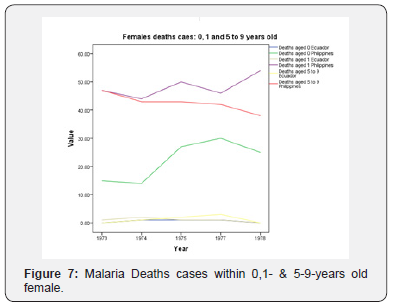Malaria Deaths Cases Comparison in the Republic of Ecuador and the Republic of Philippines
İlker Etikan*
Department of Biostatistics, Near East University, Cyprus
Submission: February 08, 2020; Published: February 27, 2020
*Corresponding author: İlker Etikan, Department of Biostatistics, Near East University, Faculty of Medicine, Nicosia-TRNC, Cyprus
How to cite this article: İlker Etikan. Malaria Deaths Cases Comparison in the Republic of Ecuador and the Republic of Philippines. Biostat Biom Open Access J. 2019; 10(1): 555778. DOI: 10.19080/BBOAJ.2020.10.555778
Abstract
Background: Malaria has since been a real burden to many countries and has been killing people around the world. Many studies have been done to provide more information about the prevalence of the disease in many countries. We compared how many people were reported deaths, in a poor and in a rich country over the years 1973 to 1978 except the year 1976.
Methodology: We used the mortality database of the World Health Organization (WHO) to get the data of malaria in the Philippines and the Republic of Ecuador. Furthermore, the World Bank Group (WBG) provided the GDP per capita [1-3] used to rank each country for the accuracy of our comparison; we used SPSS to clean, organize and to compare our data.
Results: The number of deaths cases reported for malaria over the years 1973 to 1978 excluding the year 1976 was higher in the Philippines amongst all age groups.
Conclusion: Even though the Republic of the Philippines has a higher population than the Republic of Ecuador, it is poorer since its GDP per capita is less than that of the R. of Ecuador. It also, has the greatest number of registered deaths due to malaria.
Future works: For further research, we would like to know more about the current status of malaria in these countries, what measures are put in place to eradicate it, and to improve patient treatment.
Keywords: Malaria; Poor country; Rich country; Deaths cases; WHO; WBG
Background
Malaria has been one of the major causes of deaths around the world for many decades. The efforts put to eradicate the threats have considerably increased and some countries have been able to get rid of the diseases. Our study aims to compare the prevalence of malaria by death in two countries: a rich and a poor. The World Bank Group (WBG) uses the Gross Domestic Product (GDP) per Capita to classify countries in 4 categories as mentioned in its blogs [1]:
a) Low Income (GDP per capita < $1,025.00),
b) Lower-Middle income (GDP per capita [1,026.00 – 3,995.00]),
c) Upper-Middle income (GDP per capita [3,996.00-12,375.00]),
d) High income (GDP per capita >12,375).
In this writing, our rich country is the Republic of Ecuador, an upper-middle-income with a GDP per capita equal to US$6117.82;
whereas the poor country is the Philippines, the lower-middle-income with US$3299.05 GDP per capita. Ecuador is a 283 560 km² land located in South America with Columbia and Peru as neighbors respectively in the North and the East. Philippines has a surface area of 300 000 km² and It is found in South East Asia.
Methodology
We first get the file named ‘’MortIcd08.zip’’ which represents the mortality data recorded by the World Health Organization (WHO) [2] over a period with a number of records equal to 380,627. To go through this file manually was a tedious task and prone to errors. Therefore, to alleviate our task, we choose SPSS amongst many data managing tools, to perform our analysis. For the consistency of our comparison, we decided to use data from two countries (Philippines and Ecuador) for the following years: 1973, 1974, 1975, 1977 and 1978. The age groups used in this article are 0, 1 and 5 to 9 years old. The procedure to use the recorded data is specified in the ‘’documentation.zip’’ provided by the WHO [2].
Data Structure
The data used here have been trimmed from the original file named ‘’MortIcd8.zip’’ of the WHO [3]. In that file, A031 represents the code of Malaria, 2180 is the country code of the republic of Ecuador and 3300 is the code of the Philippines. These two countries were chosen due to the availability of their data. For both two countries, the number of deaths cases of the group of people aged 2 to 4 was not available for some years. We could have used them with missing information, but it would not have better explain our vision. However, we saved the records for the years and the age groups above mentioned (Table 1 & 2).

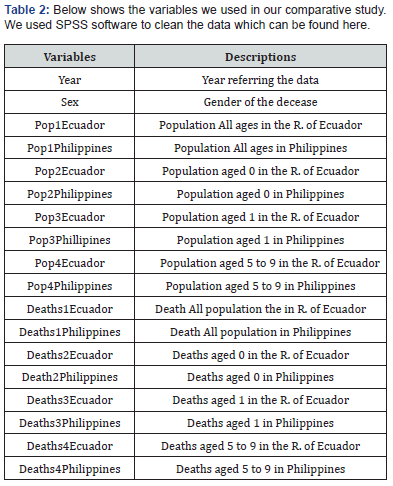
Analysis
The graphics below resulted from plots into SPSS and tell more about the population and the number of deaths due to malaria into both the republic of Philippines and the republic of Ecuador.
Results
The size area of the Philippines is 300 000 km², greater of about 15 000 km² than the surface area of the Republic of Ecuador. Its population has been about four times that of R. of Ecuador for both males and females in all age groups and years of the study figures 1-3. The Figures 4 & 5 show how higher the deaths cases, respectively for male and female are in the Philippines that in the R. of Ecuador during the study period in all age groups. In considering the size of the population, the mortality rate would still be higher in the Philippines if divide the deaths cases by 4. This is to show that malaria had killed in the Philippines than in the R. of Ecuador during the years 1973 to 1978 excluding 1976. In Figures 5-7, the maximum number of deaths (males & females) in the R. of Ecuador was equal to 3 in 1973 & 1977 while in the Philippines the minimum was 14 in 1974 and were females. Although the highest number of deaths cases was amongst children aged 1 in both two countries, males in all groups died more than did females in over the same period in the Philippines. In addition, in 1977, Philippines’ males in age groups 1 and 5-9 died almost the same number (about 49). Besides, both males witnessed an increase in deaths case from 1977 to 1978. Malaria over the given period had killed more in the Philippines than in the Republic of Ecuador.
Discussion
In this comparative study, we found that the Philippines have registered more deaths cases than the R. of Ecuador without discussing the type of vectors that led the patient to death. However, the location of each country is propitious to the proliferation of the agent vector responsible for Malaria. The Emerging Pathogens Institute of the University of Florida published in this article [4] that on April 9, 2019, many cases of malaria were noticed despite being reported clean sometimes ago.
Conclusion
The comparative study was clearly restricted to malaria deaths cases reported during the years 1973 to 1975 and 1977 to 1978. During that period, the Philippines reached many cases of deaths due to malaria in all group ages than did the Republic of Ecuador. For further research, we would like to know more about the current status of malaria in these countries, what measures are put in place to eradicate it, and to improve patient treatment.
